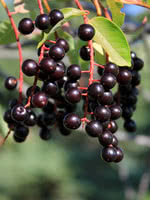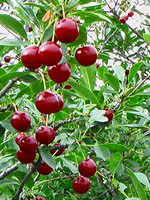Mon-Fri 9am - 5pm Mountain time
Western Chokecherry vs Juliet Cherry
Prunus virginiana var. demissa
Prunus x kerrasis Juliet
Western Chokecherry is a shrub or small tree commonly used for farmstead and field windbreaks.
It produces white flowers in the spring and edible dark purple fruit that matures between September and October. Its cherries are great for making for making jams, jellies or wine, but are not very palatable for raw eating.
Juliet Cherry is a cold-hardy dwarf sour cherry. The deep burgundy fruit are known for being sweeter than other varieties, often considered one of the sweetest dwarf sour cherries. They are well suited to fresh eating, baking, and preserves. In the spring, beautiful white flowers cover the branches, adding ornamental value.
Juliet Cherry was developed at the University of Saskatchewan. It is recommended to grow dwarf sour cherries as a shrub rather than a small tree. The shrub form tends to bear fruit earlier and is less susceptible to winterkill.
Sour cherries are self-fertile; however, planting with additional varieties for cross-pollination can increase yields.
Western Chokecherry Quick Facts
Juliet Cherry Quick Facts
Toxicity: toxic to horses, cattle, etc.)

